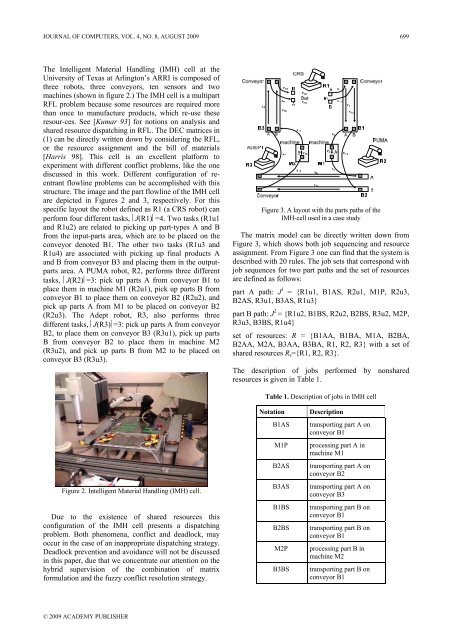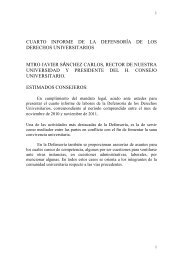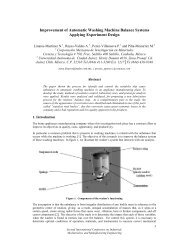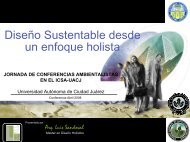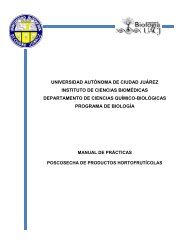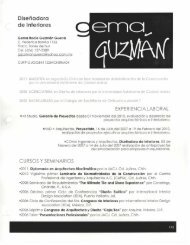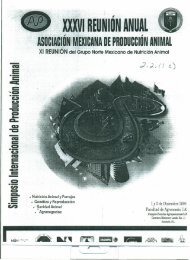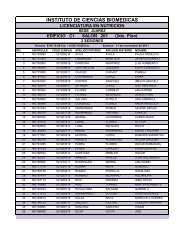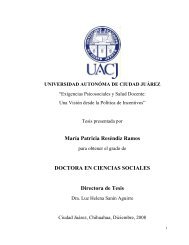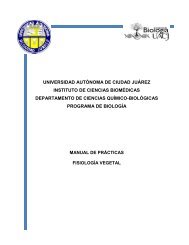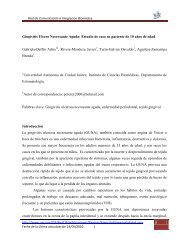journal of computers issn 1796-203x - Universidad Autónoma de ...
journal of computers issn 1796-203x - Universidad Autónoma de ...
journal of computers issn 1796-203x - Universidad Autónoma de ...
Create successful ePaper yourself
Turn your PDF publications into a flip-book with our unique Google optimized e-Paper software.
JOURNAL OF COMPUTERS, VOL. 4, NO. 8, AUGUST 2009 699<br />
The Intelligent Material Handling (IMH) cell at the<br />
University <strong>of</strong> Texas at Arlington’s ARRI is composed <strong>of</strong><br />
three robots, three conveyors, ten sensors and two<br />
machines (shown in figure 2.) The IMH cell is a multipart<br />
RFL problem because some resources are required more<br />
than once to manufacture products, which re-use these<br />
resour-ces. See [Kumar 93] for notions on analysis and<br />
shared resource dispatching in RFL. The DEC matrices in<br />
(1) can be directly written down by consi<strong>de</strong>ring the RFL,<br />
or the resource assignment and the bill <strong>of</strong> materials<br />
[Harris 98]. This cell is an excellent platform to<br />
experiment with different conflict problems, like the one<br />
discussed in this work. Different configuration <strong>of</strong> reentrant<br />
flowline problems can be accomplished with this<br />
structure. The image and the part flowline <strong>of</strong> the IMH cell<br />
are <strong>de</strong>picted in Figures 2 and 3, respectively. For this<br />
specific layout the robot <strong>de</strong>fined as R1 (a CRS robot) can<br />
perform four different tasks, ⎜J(R1)⎜=4. Two tasks (R1u1<br />
and R1u2) are related to picking up part-types A and B<br />
from the input-parts area, which are to be placed on the<br />
conveyor <strong>de</strong>noted B1. The other two tasks (R1u3 and<br />
R1u4) are associated with picking up final products A<br />
and B from conveyor B3 and placing them in the outputparts<br />
area. A PUMA robot, R2, performs three different<br />
tasks, ⎜J(R2)⎜=3: pick up parts A from conveyor B1 to<br />
place them in machine M1 (R2u1), pick up parts B from<br />
conveyor B1 to place them on conveyor B2 (R2u2), and<br />
pick up parts A from M1 to be placed on conveyor B2<br />
(R2u3). The A<strong>de</strong>pt robot, R3, also performs three<br />
different tasks, ⎜J(R3)⎜=3: pick up parts A from conveyor<br />
B2, to place them on conveyor B3 (R3u1), pick up parts<br />
B from conveyor B2 to place them in machine M2<br />
(R3u2), and pick up parts B from M2 to be placed on<br />
conveyor B3 (R3u3).<br />
Figure 2. Intelligent Material Handling (IMH) cell.<br />
Due to the existence <strong>of</strong> shared resources this<br />
configuration <strong>of</strong> the IMH cell presents a dispatching<br />
problem. Both phenomena, conflict and <strong>de</strong>adlock, may<br />
occur in the case <strong>of</strong> an inappropriate dispatching strategy.<br />
Deadlock prevention and avoidance will not be discussed<br />
in this paper, due that we concentrate our attention on the<br />
hybrid supervision <strong>of</strong> the combination <strong>of</strong> matrix<br />
formulation and the fuzzy conflict resolution strategy.<br />
© 2009 ACADEMY PUBLISHER<br />
Figure 3. A layout with the parts paths <strong>of</strong> the<br />
IMH-cell used in a case study<br />
The matrix mo<strong>de</strong>l can be directly written down from<br />
Figure 3, which shows both job sequencing and resource<br />
assignment. From Figure 3 one can find that the system is<br />
<strong>de</strong>scribed with 20 rules. The job sets that correspond with<br />
job sequences for two part paths and the set <strong>of</strong> resources<br />
are <strong>de</strong>fined as follows:<br />
part A path: J 1 = {R1u1, B1AS, R2u1, M1P, R2u3,<br />
B2AS, R3u1, B3AS, R1u3}<br />
part B path: J 2 = {R1u2, B1BS, R2u2, B2BS, R3u2, M2P,<br />
R3u3, B3BS, R1u4}<br />
set <strong>of</strong> resources: R = {B1AA, B1BA, M1A, B2BA,<br />
B2AA, M2A, B3AA, B3BA, R1, R2, R3} with a set <strong>of</strong><br />
shared resources Rs={R1, R2, R3}.<br />
The <strong>de</strong>scription <strong>of</strong> jobs performed by nonshared<br />
resources is given in Table 1.<br />
Table 1. Description <strong>of</strong> jobs in IMH cell<br />
Notation Description<br />
B1AS transporting part A on<br />
conveyor B1<br />
M1P processing part A in<br />
machine M1<br />
B2AS transporting part A on<br />
conveyor B2<br />
B3AS transporting part A on<br />
conveyor B3<br />
B1BS transporting part B on<br />
conveyor B1<br />
B2BS transporting part B on<br />
conveyor B1<br />
M2P processing part B in<br />
machine M2<br />
B3BS transporting part B on<br />
conveyor B1


